
The Araceae are a family of monocotyledonous flowering plants in which flowers are borne on a type of inflorescence called a spadix. The spadix is usually accompanied by, and sometimes partially enclosed in, a spathe. Also known as the arum family, members are often colloquially known as aroids. This family of 114 genera and about 3,750 known species is most diverse in the New World tropics, although also distributed in the Old World tropics and northern temperate regions.

Arisaema is a large and diverse genus of the flowering plant family Araceae. The largest concentration of species is in China and Japan, with other species native to other parts of southern Asia as well as eastern and central Africa, Mexico and eastern North America. Asiatic species are often called cobra lilies, while western species are often called jack-in-the-pulpit; both names refer to the distinctive appearance of the flower, which consists of an erect central spadix rising from a spathe.
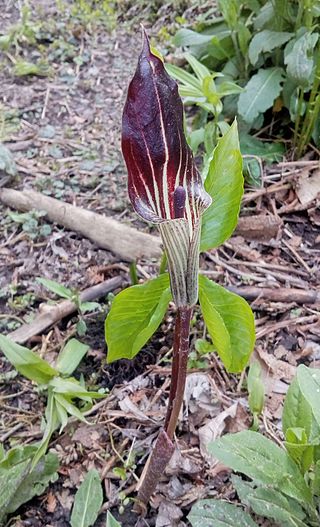
Arisaema triphyllum, the Jack-in-the-pulpit, is a species of flowering plant in the arum family Araceae. It is a member of the Arisaema triphyllum complex, a group of four or five closely related taxa in eastern North America. The specific name triphyllum means "three-leaved", a characteristic feature of the species, which is also referred to as Indian turnip, bog onion, and brown dragon.

Begoniaceae is a family of flowering plants with two genera and about 2040 species occurring in the subtropics and tropics of both the New World and Old World. All but one of the species are in the genus Begonia. There have been many recent discoveries of species in the genus Begonia, such as Begonia truncatifolia which is endemic to San Vincente, Palawan. B. truncatifolia is smaller than other species of the genus Begonia and this new species is proposed Critically Endangered by standards set by the IUCN. The only other genus in the family, Hillebrandia, is endemic to the Hawaiian Islands and has a single species. Phylogenetic work supports Hillebrandia as the sister taxon to the rest of the family. The genus Symbegonia was reduced to a section of Begonia in 2003, as molecular phylogenies had shown it to be derived from within that genus. Members of the genus Begonia are well-known and popular houseplants.

Arisaema dracontium, the dragon-root or green dragon, is a herbaceous perennial plant in the genus Arisaema and the family Araceae. It is native to North America from Quebec through Minnesota south through Florida and Texas, where it is found growing in damp woods. It has also been reported from northeastern Mexico Plants grow 20–50 centimetres (7.9–19.7 in) tall when in bloom and after flowering reach 100 centimetres (39 in), and each grows from a corm. Normally, a plant produces one leaf with a long petiole, its leaf is composed of 7 to 13 leaflets, with its central leaflet being the largest one and with leaflets becoming smaller as they are produced distally, the leaflets are held out horizontally over the plant. During flowering in spring, a single slender, green spathe 3–6 centimetres (1.2–2.4 in) long is produced; it covers a tapering, long thin spadix. The tail-like spadix grows out around the top of its spathe. After flowering, up to 150 berries are produced in a club-shaped column. In late summer, the green berries turn orange-red, each berry produces 1 to 3 seeds. It is listed as a vulnerable species in Canada.
Hiroyoshi Ohashi is a botanist formerly at the University of Tokyo and Tohoku University. He began publishing on Japanese Arisaema in the early 1960s. He published a couple of miscellaneous notes on Arisaema in 1963 and 1964 and these were followed by a revision of the genus for Japan jointly published in 1980 with J. Murata, and by the Araceae treatment for the Wildflowers of Japan.

Arisaema quinatum is a species of flowering plant in the arum family Araceae. It is a member of the Arisaema triphyllum complex, a group of closely related taxa in eastern North America. The specific name quinatum means "divided into five lobes", a reference to its characteristic leaves. It is commonly known as the southern Jack-in-the-pulpit but some refer to it as Preacher John.
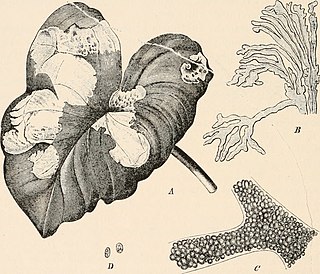
Phyllosiphon is a genus of green algae in the class Trebouxiophyceae. Unusually among the green algae, members of Phyllosiphon are often parasitic within the leaves of Araceae, causing necrosis. It has a mostly tropical to subtropical distribution, and is found primarily in the Mediterranean region, but has also been isolated in North America, Australia, Africa, and China.

Arisaema heterophyllum, the dancing crane cobra lily, belongs to the monocotyledonous flowering family Araceae. It is a perennial, rhizomatous herb native to East Asia. It has a spadix inflorescence and can be recognized by its green spathe and comparatively smaller central leaflet.
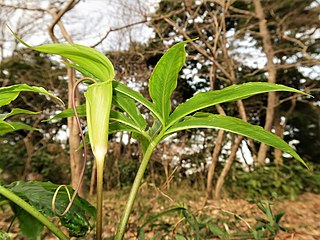
Arisaema section Clavata is a section of the genus Arisaema.
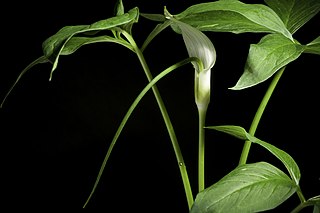
Arisaema section Odorata is a section of the genus Arisaema. This section was described in 2013 in "A nomenclatural review on the infrageneric classification of Arisaema (Araceae)" in the Journal of Japanese Botany.
Arisaema decipiens is a species of plant native to China as well as India, Myanmar, and Vietnam. It grows in evergreen forest at elevations of 600–1,600 m (2,000–5,200 ft).
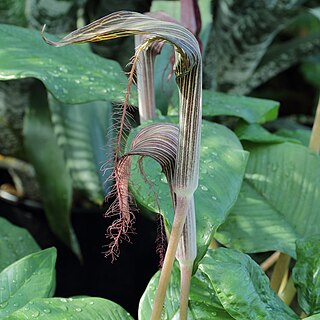
Arisaema fimbriatum is a species of Arisaema found in Thailand, Peninsular Malaysia, and Pulau Lankawi

Arisaema section Tenuipistillata is a section of the genus Arisaema.

Arisaema section Nepenthoidea is a section of the genus Arisaema.

Arisaema section Attenuata is a section of the genus Arisaema found in tropical and subtropical habitats.
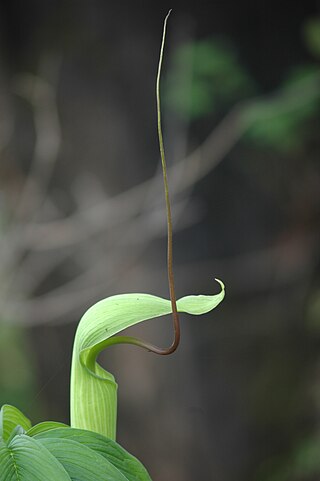
Arisaema section Tortuosa is a section of the genus Arisaema.

Arisaema section Sinarisaema is a section of the genus Arisaema.

Arisaema section Pistillata is a section of the genus Arisaema.





















